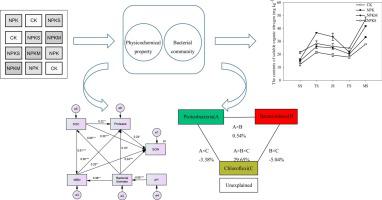Soil and Tillage Research ( IF 6.1 ) Pub Date : 2021-05-19 , DOI: 10.1016/j.still.2021.105077 Jing Yang , Wenqi Guo , Fei Wang , Fan Wang , Liming Zhang , Biqing Zhou , Shihe Xing , Wenhao Yang

|
Soil soluble organic nitrogen (SON) plays an important role in nitrogen cycling. However, the dynamic and influencing factors of SON in paddy soil are largely unknown. In this study, 36-year fertilization experiments with different fertilized (control (CK), chemical fertilizer (NPK), chemical fertilizer combined with cow manure (NPKM) and chemical fertilizer combined with straw (NPKS)) paddy soils were selected to investigate the dynamic changes and influencing factors of the SON content during the whole rice growth stage. We found that NPK, NPKM and NPKS increased the soil SON content by 20.61 %, 51.33 % and 52.50 %, respectively, compared with CK. Compared with the NPK treatment, the average SON contents in the NPKM and NPKS treatments were significantly increased by 25.46 % and 26.44 %, respectively, but there was no significant difference between the NPKM and NPKS treatments. Soil SON contents in different growth stages under the same fertilization treatments showed maturity stage > tillering stage > flowering stage > jointing stage > seedling stage. Structural equation model (SEM) analysis showed that bacterial biomass was an important factor affecting soil SON content, with a total path coefficient of 0.92, including direct path coefficients of 0.24 for soil SON and indirect path coefficients of 0.68 for soluble organic carbon, microbial biomass nitrogen and protease activity. Redundancy sequencing analysis showed that SON contents during different rice growth stages were significantly affected by the bacterial community, i.e., Chloroflexi in the early growth stage and Proteobacteria and Bacteroidetes in the later stage contributed 5.33 %, 37.40 %, and 2.17 % to the SON content variation, respectively. Conclusively, the dynamics of SON in paddy soil under long-term fertilization treatments are closely related to both fertilization treatments and the rice growth stage and are mainly affected by the bacterial community.
中文翻译:

长期不同施肥条件下稻田土壤可溶性有机氮的变化及其影响因素
土壤可溶性有机氮(SON)在氮循环中起重要作用。但是,水稻土壤中SON的动态和影响因素尚不清楚。本研究选择了36年的不同施肥稻田土壤(对照(CK),化学肥料(NPK),化学肥料与牛粪(NPKM)和化学肥料与稻草(NPKS))的施肥实验,以研究土壤肥力。水稻全生育期SON含量的动态变化及其影响因素 我们发现,与CK相比,NPK,NPKM和NPKS分别使土壤SON含量增加了20.61%,51.33%和52.50%。与NPK处理相比,NPKM和NPKS处理的平均SON含量分别显着增加了25.46%和26.44%。但是NPKM和NPKS处理之间没有显着差异。在相同的施肥处理下,不同生育期的土壤SON含量表现为成熟期>分er期>开花期>拔节期>苗期。结构方程模型(SEM)分析表明,细菌生物量是影响土壤SON含量的重要因素,总路径系数为0.92,其中土壤SON的直接路径系数为0.24,可溶性有机碳,微生物量的间接路径系数为0.68。氮和蛋白酶活性。冗余测序分析表明,水稻不同生育阶段的SON含量受到细菌群落的显着影响,即 生长初期的叶绿藻,后期的变形杆菌和拟杆菌分别对SON含量变化贡献了5.33%,37.40%和2.17%。结论是,长期施肥条件下水稻土中SON的动态变化与施肥方法和水稻生育期密切相关,且主要受细菌群落的影响。











































 京公网安备 11010802027423号
京公网安备 11010802027423号